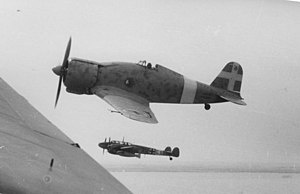Fiat G.50
| G.50 Freccia | |
|---|---|
 |
|
| A Regia Aeronautica G.50 flying with a Luftwaffe Messerschmitt Bf 110 over North Africa in 1941 | |
| Role | Fighter aircraft |
| Manufacturer | Fiat |
| Designer | Giuseppe Gabrielli |
| First flight | 26 February 1937 |
| Introduction | 1938 |
| Retired | 1946 Finnish Air Force |
| Primary users |
Regia Aeronautica Finnish Air Force Ejército del Aire Luftwaffe |
| Produced | 1935–1943 |
| Number built | 683 + 5 prototypes |
| Variants | Fiat G.55 |
The Fiat G.50 Freccia ("Arrow") was a World War II Italian fighter aircraft. First flown in February 1937, the G.50 was Italy’s first single-seat, all-metal monoplane with an enclosed cockpit and retractable undercarriage to go into production. In early 1938, the Freccias served in the Regia Aeronautica (the Italian Air Force), and with its expeditionary arm, the Aviazione Legionaria, in Spain, where they proved to be fast and, as with most Italian designs, very manoeuvrable. However, it had inadequate weaponry (two Breda-SAFAT 12.7-mm machine guns). The Fiat G.50 was also used in small numbers by the Croatian Air Force and 35 were shipped to Finland, where they served with distinction, with an unprecedented kill/loss ratio of 33/1.
The Fiat G.50 was designed by Giuseppe Gabrielli, who started planning a single-engined monoplane fighter in April 1935. Work began on two prototypes in mid-summer 1936, construction was entrusted to the workshops of the CMASA (Costruzioni Meccaniche Aeronautiche S.A.), a subsidiary of Fiat at Marina di Pisa. Comandante Giovanni de Briganti, the chief test pilot of the G.50 program, who flew the first prototype on 26 February 1937 from Caselle airfield, Turin, reaching a top speed of 472 kilometres per hour (255 kn; 293 mph) and climbing to 6,000 metres (19,700 ft) meters in six minutes, 40 seconds.
The G.50 was a low-wing monoplane of all-metal construction, with a semi-monocoque fuselage with light alloy skinning, while the wings had a steel tube centre-section structure with duralumin outer wings and alloy skins. Flaps were fitted to the aircraft's wings to improve its take-off and landing performance. The powerplant was a single Fiat A.74 R.C.38 14-cylinder air-cooled radial engine, rated at 870 hp (650 kW) for take-off and 960 hp (720 kW) at 3,000 m (9,800 ft) enclosed in a NACA cowling and driving a three-bladed constant speed propeller. The pilot sat in an enclosed cockpit under a sliding transparent canopy. He was provided with a reflector sight to aim the fighter's armament of two 12.7 mm (.5 in) Breda-SAFAT machine guns with 300 rounds of ammunition per gun fitted ahead of the cockpit, synchronised to fire through the propeller. The aircraft was fitted with a retractable landing gear, with the mainwheels retracting inwards and a castoring tailwheel. It was the first front line Italian monoplane fighter with a retractable undercarriage, an enclosed cockpit and a constant speed propeller; these improvements gave it a maximum speed that was 33 km/h (21 mph) faster than its contemporary, the Fiat CR.42 biplane.
...
Wikipedia
